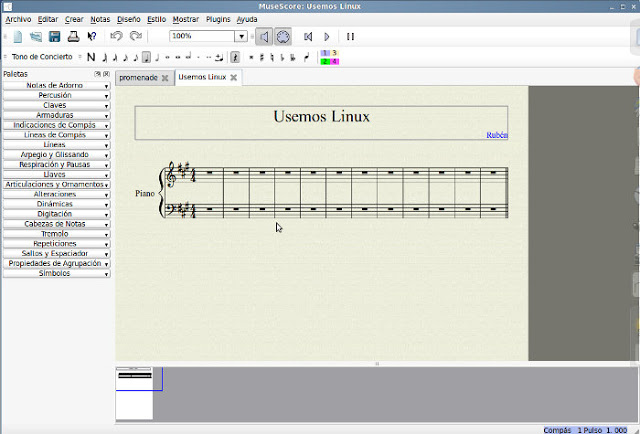
|
If you are musician or music fan and you are interested in writing scores, you can not stop knowing Musescore. |
Musescore is a free program that allows you to write scores in WYSIWYG mode (What you see is what you get) and save them in files recognizable by their .mscz extension. They can also be printed on paper with excellent quality, and they can also be exported in pdf format, even saved in midi format. And if you have a .midi you can import it to get its score.
Its use is quite simple and it is found in several languages, including Spanish. Up to four voices per staff and an unlimited number of staves (as for multiple instruments) can be included in a single score. It also allows you to listen to what you are writing note by note, or all together.
This is what the editor looks like ...
An example image of how a printed score would look:
Key features
From there I give you a summary of its main characteristics:
- WYSIWYG (What You See Is What You Get), the notes are written on a "virtual score"
- Unlimited number of staves
- Up to four voices per staff
- Quick and easy note insertion with mouse, keyboard or MIDI
- Integrated sequencer and FluidSynth software synthesizer
- Import and export MusicXml and Standard MIDI files
- Available for Windows, Mac and Linux
- GNU GPL License
Describing all the features and functionalities here is almost impossible, so I refer you to your page http://musescore.org/es
Installation
Fortunately, it is available from the official repositories of all popular distros.
En Ubuntu and derivatives:
sudo apt-get install musescore
En Fedora and derivatives:
sudo yum install musescore
En Arch and derivatives:
sudo yaourt -S musescore
In case you are out of luck, you can always download the source code and compile it. You need to get your hands a bit more dirty but it's just as effective. 🙂
Source: Musescore


I have installed musescore and well, the installation was cut off. Could it have to do with the music playing not playing? The Tuxguitar installation went well. I also installed the Fluidsynth. By the way, my distro is Linux Manjaro and the script warned me that it is dangerous to install as administrator (sudo ...). Ofu!
No, no so much…
Oh! This is more cool to me !! It eats a lot of resources too like the GuitarPro ??
I think so. Likewise, if you are a «guitar maker» I recommend that you also take a look at Tuxguitar (the Linux Guitarpro).
One question, is its function to write scores wonderful, can you write guitar tablature?
Excellent!!
Just what I needed, I installed it on OpenSUse 13.1, it works great. It has several very useful options, in Spanish and parameterizable.
If anyone knows of something better .. share it !!
If I make a score in museescore2, how can I see it in musescore1?
Thank you very much for the contribution, it really is a great program